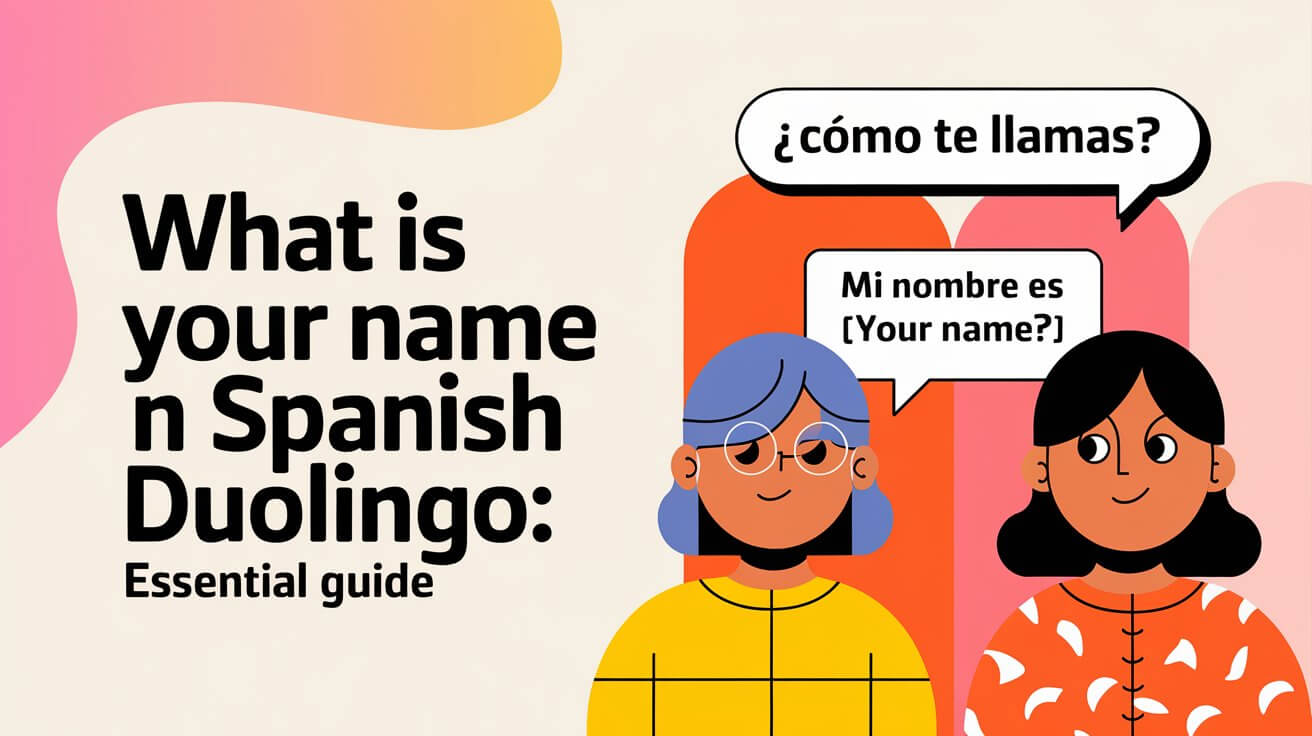Are you eager to learn how to ask “What is your name?” in Spanish using Duolingo? The phrase “¿Cómo te llamas?” is the most common way to ask this question in Spanish on Duolingo. This article will guide you through various aspects of name introductions in Spanish, Duolingo’s teaching methods, and practical tips to enhance your language skills.
The Basics of Asking “What Is Your Name” in Spanish
Common Phrases and Their Meanings
Spanish offers several ways to ask someone’s name. Let’s explore the most frequent expressions:
- ¿Cómo te llamas? – This literally translates to “How do you call yourself?” It’s the go-to phrase for informal situations.
- ¿Cuál es tu nombre? – A more direct translation of “What is your name?” This phrase is also commonly used.
- ¿Cómo se llama? – The formal version, used when addressing someone older or in a professional setting.
Each phrase has its place in Spanish conversations. Duolingo often introduces “¿Cómo te llamas?” first, as it’s widely used across Spanish-speaking countries.
Formal vs. Informal Versions
Spanish distinguishes between formal and informal speech. When asking someone’s name, you’ll need to choose the appropriate form based on your relationship with the person:
Informal (tú form):
- ¿Cómo te llamas?
- ¿Cuál es tu nombre?
Formal (usted form):
- ¿Cómo se llama?
- ¿Cuál es su nombre?
Duolingo’s Approach to Teaching Name Introductions
How Duolingo Presents the Concept
Duolingo introduces “What is your name?” early in its Spanish course. The app uses a variety of methods to teach this crucial phrase:
- Translation exercises
- Listening comprehension
- Speaking practice
- Multiple-choice questions
These diverse activities help reinforce the concept from different angles, making it easier for learners to grasp and remember.
Key Lessons and Exercises
Duolingo’s Spanish course typically includes these exercises for name introductions:
- Matching Spanish phrases with their English translations
- Filling in the blanks in dialogues
- Arranging words to form correct sentences
- Pronunciation drills
These exercises build on each other, gradually increasing in difficulty as you progress through the course.
Cultural Context of Name Introductions in Spanish-Speaking Countries
Regional Variations
While “¿Cómo te llamas?” is widely understood, some regions have their own preferred ways of asking for names:
- In parts of Latin America, “¿Cómo te dicen?” (How do they call you?) is common.
- In Spain, you might hear “¿Cómo te llamas tú?” with the added pronoun for emphasis.
Duolingo focuses on the most widely accepted forms but occasionally introduces regional variations as you advance.
Etiquette and Social Norms
Name introductions in Spanish-speaking cultures often involve more than just asking for a name. Some key points to remember:
- Use formal language with older people or in professional settings.
- It’s common to use both first and last names in formal introductions.
- In many Latin American countries, people have two last names.
Duolingo touches on these cultural aspects as you progress through the course, helping you navigate real-world conversations more effectively.
Common Mistakes and How to Avoid Them
Pronunciation Pitfalls
When asking “What is your name?” in Spanish, watch out for these common pronunciation errors:
- Misplacing stress in “¿Cómo te llamas?” – The stress is on the first syllable of “Cómo” and “llamas”.
- Mispronouncing the double ‘l’ in “llamas” – It’s pronounced like the ‘y’ in “yes”.
- Forgetting to raise your intonation at the end of the question.
Duolingo’s speaking exercises help you practice these sounds, but additional practice outside the app can improve your pronunciation significantly.
Grammar Errors to Watch Out For
Be mindful of these grammar mistakes when asking for names in Spanish:
- Using “tú” forms with “usted” or vice versa.
- Forgetting to use inverted question marks at the beginning of questions.
- Mixing up “cómo” (how) and “qué” (what) – “¿Qué te llamas?” is incorrect.
Duolingo’s exercises are designed to help you avoid these errors, but it’s crucial to pay attention to the correct forms as you practice.
Beyond “What Is Your Name”: Expanding Your Spanish Conversation Skills
Related Phrases for Introductions
Once you’ve mastered “What is your name?” in Spanish, you can expand your conversation skills with these related phrases:
- Me llamo… (My name is…)
- Mucho gusto (Nice to meet you)
- Encantado/a (Pleased to meet you)
- ¿De dónde eres? (Where are you from?)
Duolingo introduces these phrases gradually, allowing you to build more complex conversations over time.
Building on Basic Greetings
Combine name introductions with other basic greetings to create natural-sounding conversations:
- Hola, ¿cómo estás? ¿Cómo te llamas? (Hello, how are you? What’s your name?)
- Buenos días. ¿Cuál es su nombre? (Good morning. What is your name?)
- ¿Cómo te llamas? Yo soy Juan. (What’s your name? I’m Juan.)
Practice these combinations to sound more fluent and natural in your Spanish conversations.
Tips for Practicing “What Is Your Name” in Spanish
Effective Duolingo Strategies
Make the most of your Duolingo practice with these strategies:
- Use the ‘Tips’ section before starting a lesson for extra context.
- Take advantage of the ‘Practice’ feature to review name introductions regularly.
- Join Duolingo’s forums to discuss tricky aspects of Spanish name introductions with other learners.
- Set daily goals to maintain consistent practice.
Real-World Application Techniques
Extend your learning beyond Duolingo with these practical tips:
- Practice with Spanish-speaking friends or language exchange partners.
- Watch Spanish movies or TV shows, paying attention to how characters introduce themselves.
- Try introducing yourself in Spanish to strangers (when appropriate and safe to do so).
- Use language learning apps that focus on conversational Spanish to complement your Duolingo practice.
Frequently Asked Questions About “What Is Your Name” in Spanish Duolingo
Why does Duolingo teach “¿Cómo te llamas?” instead of “¿Cuál es tu nombre?”?
Duolingo often starts with “¿Cómo te llamas?” because it’s more commonly used in everyday conversations across Spanish-speaking countries.
How do I know when to use formal or informal versions?
Use informal versions (te/tu) with friends, family, and peers. Use formal versions (se/su) with older people, authority figures, or in professional settings.
Does Duolingo teach regional variations of asking for names?
While Duolingo focuses on the most widely accepted forms, it does introduce some regional variations as you progress through higher levels.
How can I practice pronunciation if I’m unsure?
Duolingo offers speaking exercises, but you can also use external resources like pronunciation guides or language exchange apps for additional practice.
What if I make a mistake when asking someone’s name in real life?
Don’t worry! Most Spanish speakers appreciate the effort to speak their language. If you make a mistake, simply apologize and try again.
How often should I practice name introductions on Duolingo?
Consistency is key. Try to practice daily, even if it’s just for a few minutes. Regular review helps reinforce the concepts.
Can I use “¿Qué es tu nombre?” to ask “What is your name?”
While grammatically correct, this phrase is less common and can sound unnatural to native speakers. Stick with “¿Cómo te llamas?” or “¿Cuál es tu nombre?”
Learning to ask “What is your name?” in Spanish is a crucial first step in your language journey. With Duolingo’s structured approach and the tips provided in this guide, you’re well on your way to mastering this essential phrase. Remember, language learning is a journey – embrace the process, make mistakes, and keep practicing. Before you know it, you’ll be confidently introducing yourself in Spanish!







